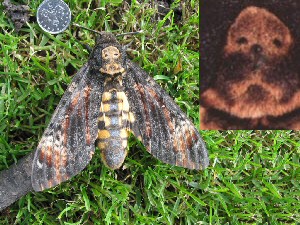Countryside Rangers Diary
October - A Death's Head Hawk moth, Acherontia atropos, was found in the Park on October 3rd. Rather a surprise as it turned up inside the Orangery!
This moth is the largest European Hawk moth. It is an unusual visitor to Britain from Southern Europe and Africa, but is unable to survive the winter. Unlike most hawk moths, it has a short proboscis and therefore cannot take nectar from deep-throated flowers. Instead, it feeds on honey from bees nests and sap from trees. It can produce a loud shrill squeak by forcing air out of its proboscis. This is supposed to subdue and control the worker bees, whose honey it is robbing.
The Moth in Myth and Legend
Because of its skull-and-crossbones markings and its unexpected ability to make quite a loud sound, the Death's Head has been an object of terror throughout the ages. Its sinister qualities are enshrined in its name: In Roman mythology Acheron is the river of sorrows that flows through the infernal region of Tartarus, where evil souls were punished; Atropos the eldest of the three Fates in control of each human's destiny, the one who severs the thread of life.
Throughout Europe, the moth was thought to be a harbinger of war, pestilence, and death to man and beast alike. Its appearance in a candlelit room, especially if it managed to snuff out the candle, was an omen of death in the house. In France, dust from its wings was thought to cause blindness if it entered the eye. The moth brought fear and panic in Brittany when large numbers appeared at the time of a widespread pestilence.
 The moth's awe-inspiring properties are markedly enhanced by the sounds it makes: these have been described as a 'dismal, melancholy cry' and like the 'plaintive squeaking of a mouse'. In Poland, where it is known as the 'wandering death-bird', its cry was heard as a voice of anguish, the moaning of a grief-stricken child.
The moth's awe-inspiring properties are markedly enhanced by the sounds it makes: these have been described as a 'dismal, melancholy cry' and like the 'plaintive squeaking of a mouse'. In Poland, where it is known as the 'wandering death-bird', its cry was heard as a voice of anguish, the moaning of a grief-stricken child.
Silence of the Lambs
The Death's Head has entered modern mythology in its role as an emblem of evil in the book and film of The Silence of the Lambs.
The species in Thomas Harris's book is the related Malaysian A. styx. The distinctive trademark of the serial murderer is a hawk moth pupa placed in the mouth of his female victims, whom he later skins. Although the pupa is identified by a museum curator in the film as that of the Death's Head, this is clearly a misidentification: the pupa has a long, jug-handled proboscis, whereas that of the Death's Head is short and stout.